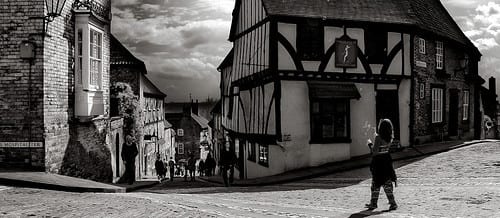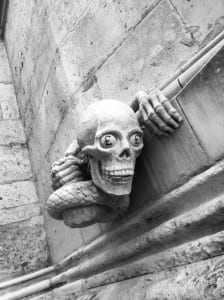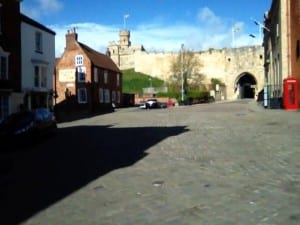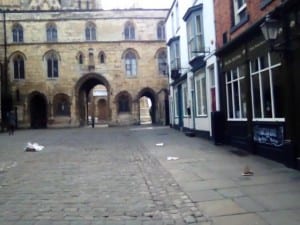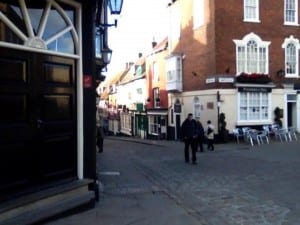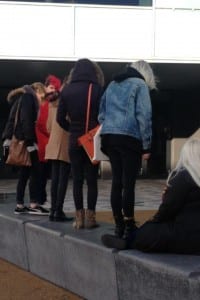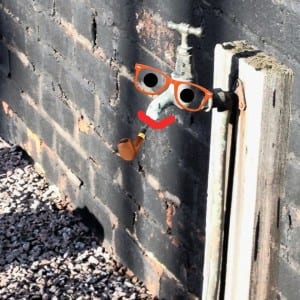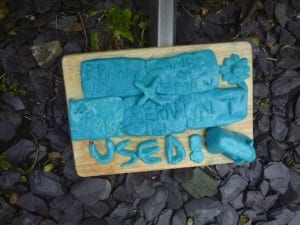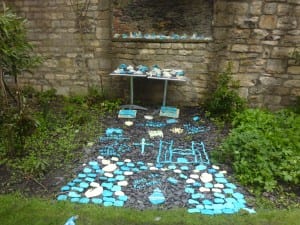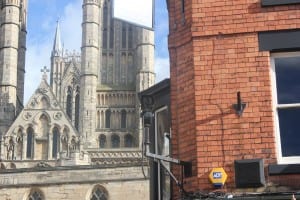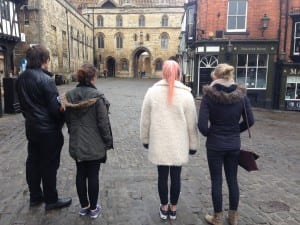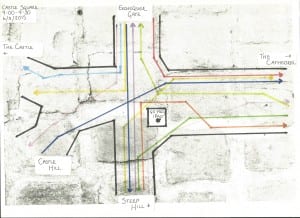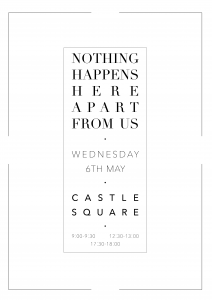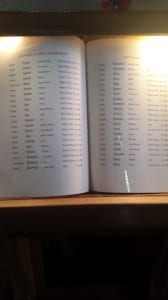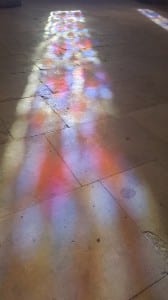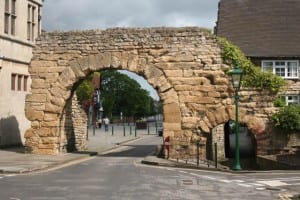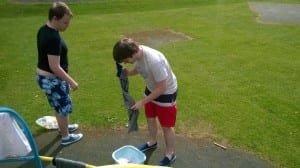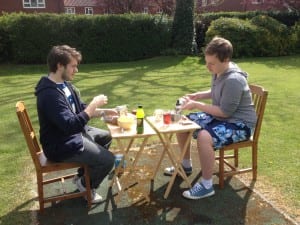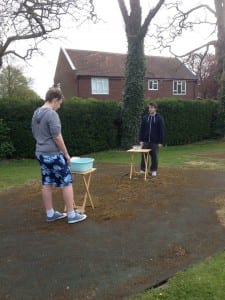Framing Statement
On Wednesday 6th May 2015 we will present our Site Specific performance ‘Nothing Happens Here Apart From Us’ in Castle Square between the hours of 9:00am-9:30am, 12:30pm-1:00pm and 17:30pm-18:00pm. Our key aim is to portray the concerning notions of surveillance regarding the violations of privacy, this is important to us as a group as we want to raise awareness to the public that we are constantly being watched as a nation.
As we are a group of five we will display this by dividing up certain roles and tasks between us, to give our performance variation whilst still performing as a unit. Firstly, another group member and I will place ourselves in the very centre of Castle Square, so that we almost become unavoidable to passers-by. We will be standing back to back, rotating in unison as the CCTV camera moves – by doing this we are illuminating the cameras presence to the public. Whilst rotating in the space and following the camera we will also be presenting a live feed of the space back to the audience through the use of an iPad and GoPro camera. Filming the public and presenting the footage back to them, will make them conscious of the fact that they are constantly being observed.
Whilst we have this system operating in the centre of Castle Square, the three other group members will be analysing the public who enter and exit the site. This will be achieved by following and noting down peoples personal journeys on a map. Castle Square entails a varied range of entrances into sites, generating a diverse mix of spectators to fill the space. ‘The people trackers’, will record their information onto maps and bring it back to the bigger source of power, ‘the hub’. The relevance of this will enable us to see how the public operate the space, with the clear understanding that they are being observed.
Audience participation is vital for our piece, as we require them for filming, they become part of our performance. We have made the decision to not advertise or invite people to our performance, as we want to encounter an accidental audience from the public. If any members of the public want to engage with us directly, or question what it is we are doing we are going to hand them a small flyer directing them towards the blog where everything can be explained in further detail. Although we have decided against marketing our play, we have agreed to make a statement poster of our performance to inform people what will be happening in the area on the specific date.
Our main influences for our performance include The Surveillance Camera Players and Tehching Hsieh. We took a high interest into these two practitioners as their work has massively influenced our piece. Documentation and surveillance have been two key areas throughout our process that have inspired us and stuck with us for the majority of our process.
Analysis of Process
Initial Thoughts and Ideas
An original idea that my group and I decided on was to pursue a guided tour around the back of the Cathedral. As we were fascinated by the mystical sculptures we discovered there.
We gained inspiration for this idea from watching the Mythogeography at the Royal William Victualling Yard: https://www.youtube.com/watch?t=230&v=qGdBtWmbc4A
Watching this empowered us with ideas on how we could create a truly fascinating mythology to incorporate into our piece. Taking our audience on an eerie journey around the back end of the Cathedral that does not appear as popular as the front of it.
Photo: (Smart, 2015).
As we moved further with this idea we began to recognize that most of our mythologies that we had made up were in fact already ‘Lincoln myths’. After this discovery we were left feeling slightly disappointed as we did not want to be seen as though we were presenting a generic ghost walk to the public.
‘Nothing Happens Here Apart From us’
Progressing on from our mythology ideas we decided to move onto something else. “Nothing happens here apart from us” an interesting quote that a group member overheard in Castle Square during our second week of Site Specific.
What really caught our attention about this quote was that it was delivered from an elderly local assuming that we were a group of tourists. Developing the quote further we started to think of ideas about how we could present a busy environment back to an audience. We wanted to show an audience how much a space can be operated by us all, encouraging them to consider what it would entail if it was constantly unoccupied.
The first thing to enable us to emerge further with this idea was to pick a space. After a lot of thought and consideration we decided to use Castle Square. What highly motivated us to choose Castle Square was the fact that it is Steep Hill’s most popular and busiest site. However, it is also a site that entails historical, religious, tourist and commercial values; broadening the combination of people who visit it. This is an important aspect for us as it generates a more varied audience for our performance. We will be able to present to this audience how many different people use and encounter this site, showcasing the site’s significance, pushing the spectators to acknowledge it would be ‘nothing’ without them.
To get familiar with our new space we decided to put into practice Mike Pearson’s Some Exercises Towards Relating Space. Following these instructions allowed us to discover interesting and unique pinpoints of the area. In particular, after visiting the site we carried on with the exercise and came across the question “What would you have remembered had you gone there without a camera?” (Pearson, 2011). My group and I all agreed that the CCTV camera above The Magna Carta pub was something that stood out for us and caught our attention.
After this, we spent a whole rehearsal analysing the CCTV camera and following its every move. We started to think deeper into the CCTV camera, and the way it worked. Who was operating it? What were they looking for? Were they following us? We became so intrigued with the way the camera moved and the angles it would record. From this we acknowledged four main points of Castle Square that the camera kept returning too, these were: the road going down steep hill, the area that covers the ground before the cathedral, the area that covers the ground before the entrance of the castle and upper steep hill.
Photos: (Smart, 2015).
As the camera mainly tackled these areas, we believe that they are immensely significant to the space, it is likely that the CCTV camera chose these angles as they are entrances to the square. The CCTV is almost acting as a guard to the site, keeping an eye on the people who enter. This became important to us because it made us recognise how the general public are not always fully aware they are being observed.
Surveillance
As we became so enthralled with the CCTV camera, we decided to research into the wider topics of surveillance, public privacy and how we are constantly being monitored as a country. We discovered some eye opening facts:
“The British Security Industry Authority (BSIA) estimated there are up to 5.9 million closed-circuit television cameras in the country”
“The survey’s maximum estimate works out at one for every 11 people in the UK”
“Surgeries and health centres have an estimated 80,000 to 159,000, while there are believed to be between 53,000 and 159,000 cameras in restaurants”
(Barrett, 2013).
After discovering these facts, it left us feeling shocked and slightly disturbed. We felt highly influenced to circulate our piece around observing others and being watched. We wanted to raise awareness within our space regarding these concerns.
We came across a group called The Surveillance Camera Players, they have highly inspired us with our process. The American group completely oppose to the idea of CCTV cameras monitoring public areas.
“they are fundamentally a pro-privacy group that sees CCTV as unable to offer any useful social function but to violate human rights. They are not professional actors but decided to use performance to mount a protest against the use of surveillance cameras in social spaces.[…] the company seeks to activate consciousness about the control of public space through performance” (Govan et al, 2007, 128-130).
Following this, our research into The Surveillance Camera Players has helped shape the basis of our piece. They inspired us to raise awareness to our audience regarding the presence of CCTV cameras, to inform our audience that they are always being constantly watched by a higher authority.
Evolving from this, an interesting factor we took into consideration is that when an individual is continually being watched, it can alter their behaviour. When you place a camera in front of somebody, they are conscious that they are being monitored and tend to act less natural. We had taken interest in the behaviours of people, whilst being recorded. An idea relating to this that we looked into was The Panopticon, the idea originating from the 1700’s of an architectural prison plan by Jeremy Bentham. The idea of the plan allows the prison officer to view the prisoners however the prisoners are unable to tell when they are being watched.
“Assuming that the omnipotent governor was always watching them, Bentham expected that this ‘new mode of obtaining power of mind over mind, in a quantity hitherto without example’ would ensure that the prisoners would modify their behaviour and work hard, in order to avoid chastisement and avoid punishment.” (UCL, 2015).
This relates to notions of our piece as we want to document the behaviour and attitudes of people when they are clearly being recorded.
More information on The Panopticon can be found at: https://www.ucl.ac.uk/Bentham-Project/who/panopticon
Documenting the Space
Having a CCTV camera, surveillance and crowd behaviour at the core of our idea, we wanted to develop something from them. We decided to record time lapse videos of the four angles that the CCTV camera always encountered. We did this as often as we could, to see if we could discover any differences in behaviour with a change in the in time, date or weather. With the assumptions that ‘people are always happy when it’s the weekend’ or ‘people are always miserable when it rains’ we wanted to see if people still portrayed these attitudes whilst clearly being watched.
Looking further into documentation as performance we came across the work of Tehching Hsieh, particularly looking at his “One Year Performance 1980-1981”. Available from: https://www.youtube.com/watch?v=tvebnkjwTeU
We felt extremely influenced by the constant documentation of the work, the persistence of it inspired us to film our site as frequently as we could to gather as much information as possible about the behaviours of people, relating back to the powers of a CCTV camera. Like Hsieh’s performance ours would also be durational, the time lapse videos we are gathered would be part of our final piece. Our idea at this point was to present the audience with the videos we had recorded. We would achieve this by playing the footage through iPads, whilst holding them and standing in the four main CCTV angles. We would present the space back to the audience, getting them to acknowledge how much Castle Square is watched by CCTV. The public are the reason CCTV occupies the space, relating back to our original point – without them the space would be nothing.
Continued Development
After receiving some constructive feedback, we have decided to change our performance ideas slightly. Firstly, we have acknowledged that presenting our documentations back to the audience could be slightly confusing as the videos are not real CCTV footage. A better way to present the space back to the audience will be through a live feed with a GoPro camera and an iPad, as it is a truthful and definite presentation of the current space.
We also took into consideration the possibility of performing to a CCTV camera, performing to an unknown audience. Forcing the CCTV operator to watch us as we are constantly in view. We believe it will be interesting for us to be so deeply into our performance with no regard for an audience, people will click that we are performing for the CCTV and become naturally intrigued.
CCTV Ballet
On the 26th March, my group and I decided to pursue the idea of performing to a CCTV camera. We performed to the CCTV camera between the times of 10.00am-10.32am. We took the theory from The Surveillance Camera Players and experimented with it. Throughout this task, I followed the CCTV camera every time it moved, making sure I was always in the vision of the operator. I stared at the camera, not breaking eye contact with it for the whole duration of the performance. I performed like this this to oppose against The Panopticon theory. The theory entails the thought process of not wanting to behave out of character due to being watched. I believe that I opposed against the theories by acting completely unnatural, and staring straight into the camera lens – making light of the fact I know its there. Whilst doing this, the other group members were entering and exiting the space portraying what is deemed to be more of a ‘normal’ behaviour. Every time the camera moved angle, the rest of the group members would join me and stare at it, and then move off into the space. Doing this enabled us to present the camera with different behaviours, making the statement we realise it is there but will behave how we choose. Our idea was to request for the CCTV footage from the council and use it on the iPads as part of our performance.
Photo: (Bingham-Davis, 2015).
Further Development
Unfortunately we were unable to obtain the footage of our CCTV ballet due to there not being enough time for the council to process it for our performance date. The ballet has still been part of our process, and it helped us shape ideas around it.
At this point, we decided to reform our ideas. We believed that two of us should mimic aspects of the CCTV camera by: moving every time the camera moves, looking as though we are being controlled by a higher force and by moving in mechanism. Whilst one of us would be filming from a GoPro and the other will be presenting what the GoPro is filming through a live stream on an iPad. Through doing this, we are being operated by the CCTV camera, filming the public right in the middle of castle square. The audience will be highly aware they are being filmed by us.
Another aspect of our performance will be the use of maps. The other group members will be following members of the public on their personal journeys entering and exiting the space. After they have recorded their journeys they will report them back to myself and Lily imitating the CCTV camera. The other group members are acting as information feeders that report back to the hub. This relates to our idea of surveillance, we are representing a higher political procedure. The fact that as a nation we are so closely watched, we cannot escape surveillance. Our performance is extremely relevant as on the day it is being performed, it is the day before the general elections. We are illustrating the power of political forces and how information is fed into a bigger system.
Performance Evaluation
Yi-Fu Tuan asks: “how long does it take to get to know a place?” (1997, 183). Do we ever fully get to know a place? Over a twelve week period we analysed and documented our space, researching it and investigating differences in time and day. The space never felt the same, different people and events within the location made the visit unique every time. However, when we came to perform in our site – the atmosphere totally changed. We had played a part in changing the space.
Our site had gone from presenting the welcoming aspects of a historical, religious and tourist fuelled environment to protesting something a little bit more invasive. After making the decision to not have an audience present, we understood that almost certainly we would be questioned on what we were doing in the space. When asked one of the three group members walking from place to place in the site would briefly answer and hand them a flyer which lead to further information on our blog. Myself and the other group member imitating the CCTV camera, decided it would be best not to communicate with any spectator as we wanted to remain focused throughout the entire process, and believed this would present a more powerful truth. Remaining silent and heavily focused naturally intrigued the public. One group member overheard a spectator say in reflection to our performance “Everyone around here is so nosey”, which we found quite ironic, but mostly it made the performance feel like it had partially achieved what it had set out to do.
The use of maps worked particularly well for our performance as the space never ran empty, there was always people to follow and journeys to be recorded. Only towards the end of the day the site became slightly quieter, which in a way could be looked upon as more powerful as it allowed us to be clearly visible by the few spectators passing through the space. It enabled the group members with maps to follow a clear route without any potential obstacles in the way.
The GoPro and iPad were key elements for the performance as they were what was being presented to the audience. After testing out the software many times in the process, the technology never failed us once and we had high confidence in it. Unfortunately, on the day of our performance the live stream between the GoPro and the iPad failed and refused to connect. To resolve this we had to turn on the iPads front camera and film from that. We encountered this problem for the first two performances of the day however, for the evening performance the live feed started working again. This did slightly affect our performance as it meant we had two cameras filming from two different angles, and our aim of representing the CCTV camera may have confused people.
If we were to develop the piece further and perform it again, I would definitely not be so reliant on technology. Although the technology was a prime element, there are definitely other ways in which we could have symbolized the CCTV. We could have made light of the CCTV camera through approaching it in a more performative aspect, similar to how we experimented with it in the process.
After studying Site Specific performance, I have understood the importance embedded in significance of a location. The cultural and historical values of a site can never be transferred to a conventional theatre. To be in the site gives a richer performance, the space involves the audience which makes a departure from traditional theatre. Our performance ‘Nothing Happens Here Apart From Us’ would not have the same impact if it were to be performed in a theatre, as we acquired an accidental audience. We wanted to put our performance into the community, to study the public and make them aware of CCTV.
For further information, results and documentation on our performance, visit our Flickr site: https://www.flickr.com/photos/nothinghappenssite
Works Cited:
Barrett, D. (2013) One surveillance camera for every 11 people in Britain, says CCTV survey. The Telegraph, 10 July. [online] Available from http://www.telegraph.co.uk/technology/10172298/One-surveillance-camera-for-every-11-people-in-Britain-says-CCTV-survey.html [Accessed 7 March 2015].
Bingham-Davis, L. (2015) Nothing Happens Here Apart From Us: CCTV Ballet. [Flickr] 26th March. Available from https://www.flickr.com/photos/lilybinghamdavis/17000871878/ [Accessed 12 May].
Das Platforms (2014) Tehching Hsieh: One Year Performance 1980-1981. [online video] Available from: https://www.youtube.com/watch?v=tvebnkjwTeU [Accessed 7 April 2015].
Govan, E., Nicholson, H. and Normington, K. (2007) Making a Performance: Devising Histories and Contemporary Practices. USA and Canada: Routledge.
Mythogeography (2010) Mythogeography at the Royal William Victualling Yard. [online video] Available from https://www.youtube.com/watch?t=230&v=qGdBtWmbc4A [Accessed 1 May 2015].
Nothing Happens Here Apart From Us (2015) Nothing Happens Here Apart From Us. [Flickr]. Available from https://www.flickr.com/photos/nothinghappenssite [Accessed 15 May].
Pearson, M. (2011) Some Exercises Towards Relating Space. [online] Available from https://blackboard.lincoln.ac.uk/bbcswebdav/pid-953326-dt-content-rid-1863756_2/courses/DRA2035M-1415/Mike%20Pearson%20%203bplaceexercises.pdf [Accessed 1 May 2015].
Smart, T. (2015) Nothing Happens Here Apart From Us: CCTV Angles. [Flickr] 15th May. Available from https://www.flickr.com/photos/131412114@N08/ [Accessed 15 May].
University College London. (2015) The Panopticon. [online] London: UCL. Available from https://www.ucl.ac.uk/Bentham-Project/who/panopticon [Accessed 5 May].
